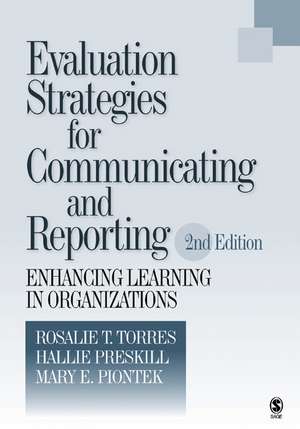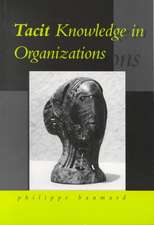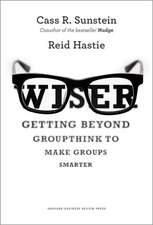Evaluation Strategies for Communicating and Reporting: Enhancing Learning in Organizations
Editat de Rosalie T. Torres, Hallie Preskill, Mary E. Pionteken Limba Engleză Paperback – 2 feb 2005
Evaluation Strategies for Communicating and Reporting has been thoroughly revised and updated creating 75% new material and 34 new case examples. The Second Edition provides worksheets and instructions for creating a detailed communicating and reporting plan based on audience needs and characteristics. The authors cover advances in technology including Web site communications, Web and videoconferencing and Internet chat rooms. There are several additional topics for consideration, including communicating and reporting for diverse audiences and for multi-site evaluations.
Preț: 800.77 lei
Preț vechi: 976.55 lei
-18% Nou
Puncte Express: 1201
Preț estimativ în valută:
153.23€ • 163.85$ • 127.76£
153.23€ • 163.85$ • 127.76£
Carte tipărită la comandă
Livrare economică 17 aprilie-01 mai
Preluare comenzi: 021 569.72.76
Specificații
ISBN-13: 9780761927549
ISBN-10: 0761927549
Pagini: 384
Ilustrații: 1
Dimensiuni: 178 x 254 x 21 mm
Greutate: 0.67 kg
Ediția:Second Edition
Editura: SAGE Publications
Colecția Sage Publications, Inc
Locul publicării:Thousand Oaks, United States
ISBN-10: 0761927549
Pagini: 384
Ilustrații: 1
Dimensiuni: 178 x 254 x 21 mm
Greutate: 0.67 kg
Ediția:Second Edition
Editura: SAGE Publications
Colecția Sage Publications, Inc
Locul publicării:Thousand Oaks, United States
Recenzii
[This is] a book that addresses some of the overlooked, taken-for-granted aspects involved with the planning, conducting, and reporting of good evaluation. This book helps evaluators improve the utilization of evaluation results by using an ongoing, integrative collaborative learning approach with project stakeholders. Through the use of collaborative techniques and emphasis on various communicating and reporting formats, evaluators gain knowledge and skills that will assist them in helping organizations learn, grow, and improve.
This is among the most thorough and practically applicable texts written about communicating and reporting evaluation findings. The additions of the new sections in this edition reflect the changing nature of work-related communication in general, of which evaluators need to be aware and take advantage. This is a significant contribution to our practice.
"Rosalie Torres, Hallie Preskill and Mary Piontek have furnished a text that is not only thorough, but also easily accessible to both the beginner and the experienced practitioner alike. Not only are they masters at writing with jargon-free clarity, what they have to say demonstrates their apparent underlying methodological grasp of the field. They have succeeded in practicing what they preach."
This is among the most thorough and practically applicable texts written about communicating and reporting evaluation findings. The additions of the new sections in this edition reflect the changing nature of work-related communication in general, of which evaluators need to be aware and take advantage. This is a significant contribution to our practice.
"Rosalie Torres, Hallie Preskill and Mary Piontek have furnished a text that is not only thorough, but also easily accessible to both the beginner and the experienced practitioner alike. Not only are they masters at writing with jargon-free clarity, what they have to say demonstrates their apparent underlying methodological grasp of the field. They have succeeded in practicing what they preach."
Cuprins
Preface
Acknowledgements
1. Introduction
Individual Learning
Group Learning
Organizational Learning
Learning Approach to Evaluation
Organization of the Book
2. Understanding and Planning for Effective Communicating and Reporting
Purposes of Communicating and Reporting
Timing
Audiences
Individual, Group, and Organizational Learning
Overview of Communicating and Reporting Formats and Options
Developing a Communicating and Reporting Plan
Summary
3. Communicating and Reporting Strategies to Facilitate Learning
Making Contents Easy to Assimilate
Short Written Communications
Interim Reports
Final Reports
Executive Summaries
Newsletters, Bulletins, Briefs, and Brochures
News Media Communications
Web Site Communications
Summary
4. Communicating and Reporting Strategies to Maximize Learning
Potentially Interactive Formats
Fully Interactive Formats
Summary
5. Creative Forms of Communicating and Reporting
Photography
Cartoons
Poetry
Drama
Summary
6. Additional Considerations for Communicating and Reporting
Communicating and Reporting for Diverse Audiences
Communicating Negative Findings
Integrating Quantitative and Qualitative Evaluation
Developing Recommendations
Multisite Evaluations
Summary
7. Issues and Opportunities for Evaluation Practice
Breadth and Depth of Skills Evaluators Need
Evaluator Roles
Time for Collaboration
Misinterpretation/Misuse of Findings
Organizational Readiness for Evaluation
Parting Thought
Appendix A: Key Terms
Appendix B: Summary of Chapter 3 Implementation Tips, Guidelines, and Cautions
Appendix C: Summary of Chapter 4 Implementation Tips, Guidelines, and Cautions
Appendix D: Summary of Chapter 5 Implementation Tips and Cautions
Appendix E: Summary of Chapter 6 Implementation Tips and Cautions
References
Index
About the Authors
Acknowledgements
1. Introduction
Individual Learning
Group Learning
Organizational Learning
Learning Approach to Evaluation
Organization of the Book
2. Understanding and Planning for Effective Communicating and Reporting
Purposes of Communicating and Reporting
Timing
Audiences
Individual, Group, and Organizational Learning
Overview of Communicating and Reporting Formats and Options
Developing a Communicating and Reporting Plan
Summary
3. Communicating and Reporting Strategies to Facilitate Learning
Making Contents Easy to Assimilate
Short Written Communications
Interim Reports
Final Reports
Executive Summaries
Newsletters, Bulletins, Briefs, and Brochures
News Media Communications
Web Site Communications
Summary
4. Communicating and Reporting Strategies to Maximize Learning
Potentially Interactive Formats
Fully Interactive Formats
Summary
5. Creative Forms of Communicating and Reporting
Photography
Cartoons
Poetry
Drama
Summary
6. Additional Considerations for Communicating and Reporting
Communicating and Reporting for Diverse Audiences
Communicating Negative Findings
Integrating Quantitative and Qualitative Evaluation
Developing Recommendations
Multisite Evaluations
Summary
7. Issues and Opportunities for Evaluation Practice
Breadth and Depth of Skills Evaluators Need
Evaluator Roles
Time for Collaboration
Misinterpretation/Misuse of Findings
Organizational Readiness for Evaluation
Parting Thought
Appendix A: Key Terms
Appendix B: Summary of Chapter 3 Implementation Tips, Guidelines, and Cautions
Appendix C: Summary of Chapter 4 Implementation Tips, Guidelines, and Cautions
Appendix D: Summary of Chapter 5 Implementation Tips and Cautions
Appendix E: Summary of Chapter 6 Implementation Tips and Cautions
References
Index
About the Authors
Descriere
Evaluation Strategies for Communicating and Reporting has been thoroughly revised and updated creating 75% new material and 34 new case examples. The Second Edition provides worksheets and instructions for creating a detailed communicating and reporting plan based on audience needs and characteristics. Authors Rosalie T. Torres, Hallie Preskill, and Mary E. Piontek cover advances in technology including Web site communications, Web and videoconferencing, and Internet chat rooms. Also mentioned are several additional topics for consideration, including communicating and reporting for diverse audiences and for multi-site evaluations.













